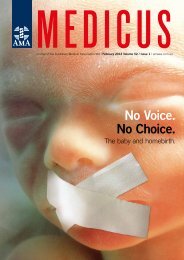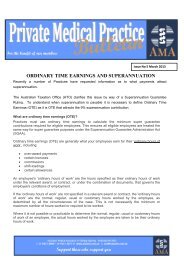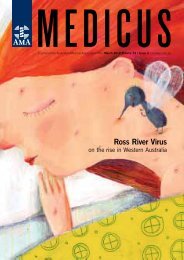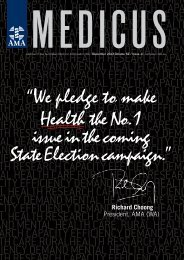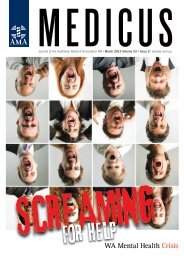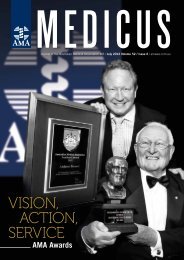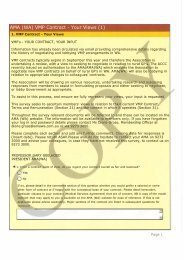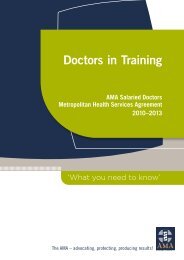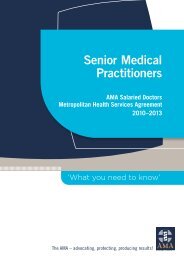twrama 1990_final oc.. - AMA WA
twrama 1990_final oc.. - AMA WA
twrama 1990_final oc.. - AMA WA
Create successful ePaper yourself
Turn your PDF publications into a flip-book with our unique Google optimized e-Paper software.
Determined: Ass<strong>oc</strong>iate Professor<br />
Gary Robinson hopes a concerted<br />
approach involving community<br />
action and action across services<br />
and agencies will help diminish<br />
the spectre of suicide.<br />
COVER STORY<br />
Fighting for<br />
life<br />
Menzies researchers traverse the country to speak to<br />
communities about preventing Indigenous suicide<br />
“Our mob don’t like asking for help. We are proud. It takes<br />
a lot of courage to ask for help,” advises a plain-speaking<br />
Indigenous community representative.<br />
He’s talking with researchers from the Menzies Centre<br />
or Child Development and Education (CCDE) who are in<br />
his region to collect information and stories about Indigenous<br />
suicide.<br />
“It can take a fair amount of courage for Indigenous<br />
people from regional or remote communities to stand up and<br />
talk in this environment,” says lead researcher, Ass<strong>oc</strong>iate<br />
Professor Gary Robinson. “Communities can go into denial<br />
about suicide and become too ashamed or<br />
frightened to talk about it openly.”<br />
Battling against the horrors of Indigenous<br />
suicide sounds like a grim task. However<br />
this recent series of consultations were<br />
characterised more by determination to make<br />
things better, than they were by any sense<br />
of despair.<br />
Researchers criss-crossed the country<br />
during August and September conducting<br />
public consultations in 16 capital cities and<br />
regional centres in points as far distant as<br />
Thursday Island, Hobart, Perth and Broome.<br />
Their ultimate task was to seek the<br />
information that may help to reduce<br />
the distressingly high rates of suicide in<br />
Indigenous communities around Australia.<br />
The team, lead by A/Prof Robinson,<br />
has been charged with capturing material<br />
to feed into the development of a National<br />
Aboriginal and Torres Strait Islander<br />
Indigenous Suicide Prevention Plan. It has spoken to more<br />
than 500 people and received over 50 submissions to the<br />
consultation website<br />
www.indigenoussuicideprevention.org.au.<br />
There was a steely resolve on the part of the Indigenous<br />
and non-Indigenous people who attended the sessions to<br />
apply themselves to the problem and work hard to develop<br />
answers to the scourge of Indigenous suicide.<br />
“There was a sense of hope on the part of people who want<br />
to be heard,” said A/Prof Robinson. “They want to know<br />
what the options are, and have input into the strategies that<br />
reflect the views of their communities.”<br />
There were some expressions of grief from community<br />
members present who referred to their direct personal<br />
experience of losing loved ones to suicide. The consultations<br />
provided a supportive environment and it seemed that people<br />
drew strength from being able to recount their own stories in<br />
a safe space.<br />
A healthy representation of Indigenous people was present<br />
at all the consultations. As A/Prof Robinson noted, there can<br />
be no suggestion that Aboriginal people are unwilling to take<br />
responsibility for developing solutions to the thorny problems<br />
they face.<br />
This was not an <strong>oc</strong>casion for navel gazing, he added.<br />
People were f<strong>oc</strong>used on the distinctly concrete task of<br />
developing a strategy that will help save lives. They were<br />
animated by a sense that something could be done – and that<br />
something would be done to prevent suicide.<br />
“I was blown away by how much people knew and how<br />
willing they were to talk about things,”<br />
recalls Bernard Leckning, a research team<br />
member who attended a number of the<br />
consultations.<br />
“You are talking about people who<br />
are pretty determined to get something<br />
done. People were animated by a belief<br />
that something needs to be done about the<br />
situation.”<br />
Despite the nature of the subject matter,<br />
there were moments of humour. A video<br />
that featured Tiwi Islands crooners B2M<br />
warning against the misuse of s<strong>oc</strong>ial media,<br />
for instance, generated more than a few<br />
laughs.<br />
An Indigenous representatives at one<br />
consultation also regaled those present with<br />
a tale of A/Prof Robinson being chased by<br />
a feral donkey – apparently unimpressed by<br />
academic standing – during an earlier visit<br />
to Anangu Pitjantjatjara Yankunytjatjara<br />
lands of South Australia.<br />
Although the consultations have finished, the team still has<br />
an enormous task ahead to distil the wealth of material they<br />
have collected and synthesise it into a cohesive response for<br />
government by the end of October.<br />
They will also be acutely aware of the importance of<br />
honouring the contributions of the many Australians –<br />
Indigenous and non-Indigenous – who gave up their time and<br />
contributed their expertise at l<strong>oc</strong>ations all across the country.<br />
“Tough topics often bring the biggest rewards in terms of<br />
working with people and finding common ground,” says<br />
A/Prof Robinson.<br />
The work of his team isn’t easy, he adds, but it is<br />
critically important to grapple with the reality of suicide if<br />
governments and research organisations are to partner with<br />
Indigenous communities in finding a way forward.<br />
“This bleak toll of misery must be stemmed,” A/Prof<br />
Robinson says. ■<br />
October MEDICUS 27




